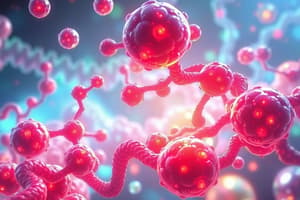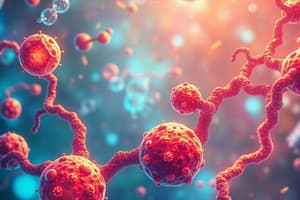Podcast
Questions and Answers
What does the 2nd Law of Thermodynamics state about energy transfers?
What does the 2nd Law of Thermodynamics state about energy transfers?
- Energy transfers can occur without any loss of energy.
- Energy transfers increase the entropy of the universe. (correct)
- Energy transfers decrease the entropy of the universe.
- Energy transfers are 100% efficient.
What happens to energy during an energy transfer according to the 2nd Law of Thermodynamics?
What happens to energy during an energy transfer according to the 2nd Law of Thermodynamics?
- The amount of usable energy increases in a closed system.
- Some energy becomes unusable and is often lost as heat. (correct)
- All energy is transformed into kinetic energy.
- Energy is never lost; it is always conserved.
What is entropy a measure of?
What is entropy a measure of?
- Randomness and disorder in a system. (correct)
- The efficiency of energy transfers.
- The total energy of a system.
- The amount of usable energy in a system.
Which process is considered energetically favorable according to the 2nd Law of Thermodynamics?
Which process is considered energetically favorable according to the 2nd Law of Thermodynamics?
What by-products of metabolism contribute to entropy according to the example provided?
What by-products of metabolism contribute to entropy according to the example provided?
What happens to the order of a system when more energy is lost to its surroundings?
What happens to the order of a system when more energy is lost to its surroundings?
What does a high entropy in a system indicate?
What does a high entropy in a system indicate?
What type of free energy change is associated with spontaneous processes?
What type of free energy change is associated with spontaneous processes?
In the Gibbs Free Energy equation, what does the term T represent?
In the Gibbs Free Energy equation, what does the term T represent?
How does free energy change relate to stability in a living system?
How does free energy change relate to stability in a living system?
What occurs at maximum stability of a system?
What occurs at maximum stability of a system?
What effect does a spontaneous process have on the free energy of a system?
What effect does a spontaneous process have on the free energy of a system?
Which factor is NOT included in the Gibbs Free Energy equation?
Which factor is NOT included in the Gibbs Free Energy equation?
What happens to the order in a system when entropy increases?
What happens to the order in a system when entropy increases?
What defines metabolism within an organism?
What defines metabolism within an organism?
Which process is an example of a catabolic pathway?
Which process is an example of a catabolic pathway?
What is the emergent property of life that arises from molecular interactions within cells?
What is the emergent property of life that arises from molecular interactions within cells?
In which of the following examples does an organism convert energy to light?
In which of the following examples does an organism convert energy to light?
Which type of metabolic pathway consumes energy?
Which type of metabolic pathway consumes energy?
What role do enzymes play in metabolic pathways?
What role do enzymes play in metabolic pathways?
What is the definition of energy?
What is the definition of energy?
Which type of energy is associated with the movement of atoms and molecules?
Which type of energy is associated with the movement of atoms and molecules?
What does the first law of thermodynamics state?
What does the first law of thermodynamics state?
Which energy form is defined as being available for release in a chemical reaction?
Which energy form is defined as being available for release in a chemical reaction?
When a diver jumps from a diving platform, what type of energy is primarily converted during the dive?
When a diver jumps from a diving platform, what type of energy is primarily converted during the dive?
What happens to a diver's potential energy when they enter the water?
What happens to a diver's potential energy when they enter the water?
What characterizes kinetic energy?
What characterizes kinetic energy?
In the context of energy transformation, what does the term 'potential energy' refer to?
In the context of energy transformation, what does the term 'potential energy' refer to?
Flashcards are hidden until you start studying
Study Notes
Overview of Cellular Energy
- Living cells function as miniature chemical factories, performing thousands of reactions.
- Cells extract and utilize energy to perform work.
- Some organisms, like firefly squids and Mycena mushrooms, convert energy into light through bioluminescence.
Metabolism and Thermodynamics
- Metabolism encompasses the total chemical reactions in an organism, transforming matter and energy.
- Metabolic processes are governed by thermodynamic laws and result from molecular interactions within cells.
Metabolic Pathways
- Catabolic pathways: Release energy by breaking down complex molecules into simpler ones (e.g., cellular respiration breaking down glucose).
- Anabolic pathways: Consume energy to synthesize complex molecules from simpler substances (e.g., protein synthesis from amino acids).
Forms of Energy
- Energy is the capacity to cause change and exists in various forms, including:
- Potential energy: Related to an object's position or structure.
- Kinetic energy: Associated with motion.
- Thermal energy: Kinetic energy from random atomic/molecular movement.
- Chemical energy: Potential energy available for release in chemical reactions.
Laws of Thermodynamics
- Thermodynamics studies energy transformations.
- First law: Energy cannot be created or destroyed, only transferred or transformed.
- Second law: Every energy transfer increases the universe's entropy, making it more disordered.
First Law of Thermodynamics
- Energy conservation principle: Energy can change forms but remains constant in total amount.
Second Law of Thermodynamics
- Energy transformations result in increased entropy (randomness) in the universe.
- Some energy becomes unusable and is lost as heat during transformations.
- Spontaneous processes increase entropy and do not require energy input.
Entropy and Energy
- High entropy indicates high disorder and low energy; low entropy reflects more order and higher energy states.
Measure of Entropy: Gibb’s Free Energy
- Gibb's Free Energy equation: ΔG = ΔH - TΔS, where:
- ΔG: Change in free energy.
- ΔH: Change in enthalpy (heat content).
- T: Absolute temperature in Kelvin.
- ΔS: Change in entropy.
- Processes with negative ΔG are spontaneous and can perform work.
Free Energy, Stability, and Equilibrium
- Free energy in living systems enables work under cellular conditions.
- Spontaneous processes decrease free energy (negative ΔG) and increase stability.
- Maximum stability, or equilibrium, occurs when a system has reached the lowest possible free energy where no net work can be done.
Studying That Suits You
Use AI to generate personalized quizzes and flashcards to suit your learning preferences.




